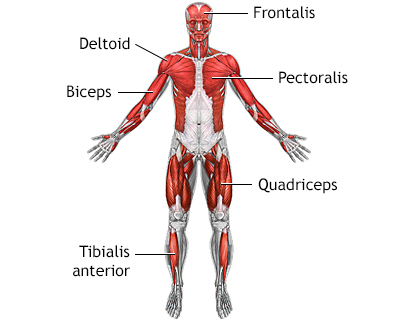Polymyositis - adult
Polymyositis and dermatomyositis are rare inflammatory diseases. (The condition is called dermatomyositis when it involves the skin.) These diseases lead to muscle weakness, swelling, tenderness, and tissue damage. They are part of a larger group of diseases called myopathies, more specifically inflammatory myopathies.

Superficial muscles are close to the surface of the skin. Muscles which lie closer to bone or internal organs are called deep muscles.
Causes
Polymyositis affects the skeletal muscles. It is also known as idiopathic inflammatory myopathy. The exact cause is unknown, but it may be related to an autoimmune reaction or infection.
Polymyositis can affect people at any age. It is most common in adults between ages 50 and 60, and in older children. It affects women twice as often as men. It is more common in African Americans than white people.
Symptoms
Polymyositis is a systemic disease. This means it affects the whole body. Muscle weakness and tenderness can be signs of polymyositis. A rash is a sign of a related condition, dermatomyositis.
Common symptoms include:
- Muscle weakness in the shoulders and hips. This can make it hard to raise the arms over the head, get up from a sitting position, or climb stairs.
- Difficulty swallowing.
- Muscle pain.
- Problems with the voice (caused by weak throat muscles).
- Shortness of breath.
You may also have:
- Fatigue
- Fever
- Joint pain
- Loss of appetite
- Morning stiffness
- Weight loss
- Skin rash on the back of the fingers, on the eyelids, or on the face
Exams and Tests
Tests may include:
- Autoimmune antibodies and inflammation tests
- Serum CPK (creatine phosphokinase)
- Serum aldolase
- Electromyography
- MRI of affected muscles
- Muscle biopsy
- Myoglobin in the urine
- ECG
- Chest x-ray and CT scan of the chest
- Pulmonary function tests
- Esophageal swallowing study
- Myositis specific and associated autoantibodies
People with this condition also must be watched carefully for signs of cancer.
Treatment
The main treatment is the use of corticosteroid medicines. The dose of medicine is slowly tapered off as muscle strength improves. This takes about 4 to 6 weeks. You will stay on a low dose of a corticosteroid medicine after that for a longer period of time.
Medicines to suppress the immune system may be used to replace the corticosteroids. These medicines may include azathioprine, methotrexate or mycophenolate.
For disease that remains active in spite of corticosteroids, intravenous gamma globulin has been tried with mixed results. Biologic drugs also may be used. Rituximab appears to be the most promising. It is important to rule out other conditions in people who do not respond to treatment. A repeat muscle biopsy may be needed to make this diagnosis.
If the condition is associated with a tumor, it may improve if the tumor is removed.
Outlook (Prognosis)
Response to treatment varies, based on the complications. As many as 1 in 5 people may die within 5 years of developing the condition.
Many people, especially children, recover from the illness and do not need ongoing treatment. For most adults, however, immunosuppressant drugs are needed to control the disease.
The outlook for people with lung disease with the anti-MDA-5 antibody is poor despite current treatment.
In adults, death may result from:
- Malnutrition
- Pneumonia
- Respiratory failure
- Severe, long-term muscle weakness
The major causes of death are cancer and lung disease.
Possible Complications
Complications may include:
- Calcium deposits in the affected muscles, especially in children with the disease
- Cancer
- Heart disease, lung disease, or abdominal complications
When to Contact a Medical Professional
Contact your health care provider if you have symptoms of this disorder. Seek emergency treatment if you have shortness of breath and difficulty swallowing.
References
Aggarwal R, Rider LG, Ruperto N, et al. 2016 American College of Rheumatology/European League against rheumatism criteria for minimal, moderate, and major clinical response in adult dermatomyositis and polymyositis: an international myositis assessment and clinical studies group/paediatric rheumatology international trials organisation collaborative initiative. Arthritis Rheumatol. 2017;69(5):898-910. PMID: 28382787
Baig S, Paik JJ. Inflammatory muscle disease - an update. Best Pract Res Clin Rheumatol. 2020;34(1):101484. PMID: 32046904
Greenberg SA. Inflammatory myopathies. In: Goldman L, Schafer AI, eds. Goldman-Cecil Medicine. 26th ed. Philadelphia, PA: Elsevier; 2020:chap 253.
Nagaraju K, Aggarwal R, Lundberg IE. Inflammatory diseases of muscle and other myopathies In: Firestein GS, Budd RC, Gabriel SE, Koretzky GA, McInnes IB, O'Dell JR, eds. Firestein & Kelley's Textbook of Rheumatology. 11th ed. Philadelphia, PA: Elsevier; 2021:chap 90.
Yoshida N, Okamoto M, Kaieda S, et al. Association of anti-aminoacyl-transfer RNA synthetase antibody and anti-melanoma differentiation-associated gene 5 antibody with the therapeutic response of polymyositis/dermatomyositis-associated interstitial lung disease. Respir Investig. 2017;55(1):24-32. PMID: 28012490
Version Info
Last reviewed on: 1/25/2023
Reviewed by: Neil J. Gonter, MD, Assistant Professor of Medicine, Columbia University, NY and private practice specializing in Rheumatology at Rheumatology Associates of North Jersey, Teaneck, NJ. Review provided by VeriMed Healthcare Network. Also reviewed by David C. Dugdale, MD, Medical Director, Brenda Conaway, Editorial Director, and the A.D.A.M. Editorial team.
